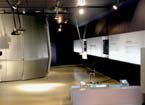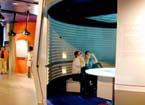The Ars Electronica Center’s 1st Upper Level that was revamped in 2002 is now presenting the “Hidden Worlds” exhibition, an in-depth encounter with the permanent presence of digital data and information flows. How do we perceive our reality and how can we imagine things that only virtually exist.
The various installations that make up “Hidden Worlds” approach this concept of an imaginary, secret world of bits and bytes in a fun, playful way. Augmented Reality technologies and artistic interpretations of the exhibit’s theme bring forth aesthetic and sensory observatories for the perception of these virtual realities.
The spatial design as a whole gives the impression that all the information and projects—which, naturally, call for the use of complicated technologies but basically get by with relatively normal hardware—seem to be floating in space. With the hardware remaining in the background, the requisite space can be given over to the presentation of content without the usual limitations that are associated with the everyday use of the computer as a medium for the generation of pictures and information.
The aim of the design was an innovative integration of the necessary technology into the objects that make up the exhibition and the creation of new forms of user interfaces by keeping the means that were used in each project as simple as possible. This imparts to the visitor the impression of individual installations instead of stringing together a series of monitors like in other conventional exhibits. The boundaries between space and technology begin to blur as space itself becomes a mediator and a part of the exhibition’s setting.
A perfect acoustic environment is necessary for the sound tracking technology in the main installation. What the designers came up with is a cylindrical space featuring a carpeted floor and a wall covering of pyramid-shaped, plastic foam tiles. The sounds made by visitors in that space are captured, transferred into a visual form and finally projected onto a table that becomes a user interface thereby. These images are fed into the user’s field of vision through the use of semi-transparent data glasses; in this way, the sound is made visible at the precise point at which it originated.
The “Info Benches” installation thematicizes approaches to so-called Augmented Reality—the blending of reality and Virtual Reality. Information is projected onto objects protruding from the floor. Directly facing the objects is a bench that can accommodate 3-4 users and is integrated with a navigation system for the “screens” that consists of transparent touch pads. In this installation, the mode of navigation and the “screens” are separated from each other without the mode of connection being apparent to the visitor. The three screens run synchronously with the information basically extending across all of them, though each can be operated separately if need be.
In conceiving and realizing the artistic projects, prime emphasis was placed on the development of new forms of interfaces as well as the integration of technical aids in a way that was as unobtrusive as possible.
| |
|
|
|
|
||

